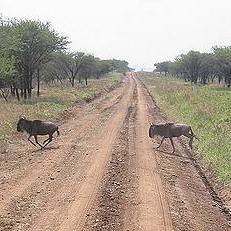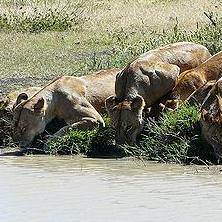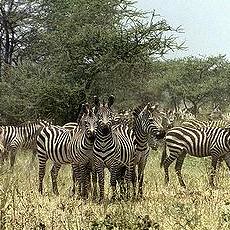 ※ 編按:去年坦尚尼亞計畫開公路,非洲「百萬牛羚大遷徙」的路徑遭切斷的消息曝光後,引起國際保育社群關切;如今,該國政府從善如流,決議擱置開路計畫。
※ 編按:去年坦尚尼亞計畫開公路,非洲「百萬牛羚大遷徙」的路徑遭切斷的消息曝光後,引起國際保育社群關切;如今,該國政府從善如流,決議擱置開路計畫。
非洲坦尚尼亞政府日前向聯合國教科文組織表示,原定穿越賽倫蓋提國家公園(Serengeti National Park)、危及全球僅存大遷徙生態奇景的高速公路計畫,已決定擱置。
該國府原先希望開闢一條公路,用來連結維多利亞湖地區與坦尚尼亞東部,相關的調查作業皆已完成;只是,公路會經過國家公園範圍內、已列為世界遺產的原始荒野地帶。
坦尚尼亞自然資源與旅遊部長Ezekiel Maige在23日證實,道路興建計畫將擱置,以進行更多的研究,原本的旅遊路線仍維持石子路,公園外到首都地區的道路則將進行升級。
部長表示,「做成這個決定,是為了兼顧坦尚尼亞北部農村的社會經濟需要,以及賽倫蓋提國家公園舉世獨特的價值。」
保育人士警告,塞倫蓋提國家公園是世界上最大的受保護草原與熱帶草原生態系。穿過公園的公路將是引進入侵動植物與疾病的媒介,盜獵者也可藉此侵入公園內的原始地區。
例如,在賽倫蓋提國家公園以及鄰近所屬肯亞的馬賽馬拉動物保護區(Masai Mara Game Reserve)中,盜獵問題已經成為管理上最大的挑戰。
賽倫蓋提國家公園 全球密度最高的肉食動物棲息地
在這裡, 由包含牛羚、斑馬等兩百萬隻草食動物形成了圓形的大隊伍,尋找著食物與飲水;並支持著全球最高密度的肉食動物,以及450多種鳥類。
由包含牛羚、斑馬等兩百萬隻草食動物形成了圓形的大隊伍,尋找著食物與飲水;並支持著全球最高密度的肉食動物,以及450多種鳥類。
公園的存在、以及動物遷徙的奇景,對坦尚尼亞的國家經濟與旅遊業非常重要。旅遊業是坦尚尼亞最大的外匯收入來源。2009年產值高達10億美元,並提供了60多萬個就業機會。坦尚尼亞的塞倫蓋提是首屈一指的旅遊勝地,比該國任何地方都吸引觀光客。
政府的這個決定,意味著賽倫蓋提北部的道路將由坦尚尼亞國家公園署(TANAPA)繼續管理。
根據坦尚尼亞政府所提供的數字,到2015年,計劃的道路使用量將是每天800車次,大約每兩分鐘一輛。到2035年,每天至少有3000車次,也就是每30秒就有一輛車上路。車輛與野生動物衝突將是不可避免的。
一旦開路 大遷徙將成絕響
野生動物專家警告,道路對遷徙的牛羚群是個障礙,也對仰賴牛羚的天敵造成影響,其中包括全球最重要的獅群,將會受到災難性影響。
 法蘭克福動物學會的專家表示,如果道路興建,180萬頭動物的大遷徙將只剩下1/3,使大遷徙成為絕響。
法蘭克福動物學會的專家表示,如果道路興建,180萬頭動物的大遷徙將只剩下1/3,使大遷徙成為絕響。
今年早些時候,德國聯邦發展部長Dirk Niebel宣布,德國願意資助一項研究,研擬其他連結賽倫蓋提北方既有道路的方案,而不穿越賽倫蓋提。
非營利旅遊業者「塞倫蓋提觀察組織」發表聲明指出,危機仍未解出, 「我們取得了一個戰役的勝利,但拯救塞倫蓋提的爭戰還在持續;因為道路仍將興建到公園的邊界,塞倫蓋提公園所承受的壓力、包括連結烏干達的商業走廊仍然存在。橫跨塞倫蓋提的開路計畫已三度浮上檯面,未來還是會有人再度提出。」
A proposed commercial highway that would have bisected the Serengeti National Park, jeopardizing the world's last great migration of mammals, has been put on hold, the Tanzanian government has told the UNESCO World Heritage Committee meeting in Paris.
The government of Tanzania wanted to build a high-speed highway across a pristine, remote wilderness area of the park, which is World Heritage site, to link the Lake Victoria area with eastern Tanzania. Survey markers are already in place.
Ezekiel Maige, Tanzania's minister of natural resources and tourism, confirmed Thursday that the planned road would be halted pending more study, and the existing tourist route would remain a gravel road, while roads outside the park to district capitals would be upgraded.
"This decision has been reached in order to address the increasing socio-economic needs of the rural communities in northern Tanzania, while safeguarding the Outstanding Universal Value of Serengeti National Park," said the minister.
Serengeti National Park is the world's largest protected grassland and savannah ecosystem. A paved road used by high-speed traffic to cross the Serengeti would act as a pathway for invasive plants, animals and diseases as well as poachers to penetrate the park's pristine areas, conservationists warn.
Poaching already poses the primary management challenge in both the Serengeti National Park and the adjacent Masai Mara Game Reserve in Kenya, which form part of a contiguous ecosystem.
Shaped by the circular march of some two million herbivores, including wildebeest and zebra searching for forage and water, the Serengeti supports one of the world's highest concentrations of large predators, and is inhabited by over 450 bird species.
The park and the migrating animals are of great importance for Tanzania's tourism industry and the country's economy. Tourism is Tanzania's largest foreign revenue earner. It raised over US$1 billion in 2009 and provided more than 600,000 jobs. The Serengeti is Tanzania's premier tourist destination, attracting more visitors than any other place in the country.
The government's decision means that tracks through the northern Serengeti will continue to be managed by Tanzania National Parks, known as TANAPA.
By 2015, the proposed road would have been used by 800 vehicles a day, about one every two minutes. By 2035, by at least 3,000 vehicles a day, one every 30 seconds, would have used the road, according to Tanzanian government figures. Vehicle-wildlife collisions would have been inevitable.
The road would have acted as a barrier to migrating herds of wildebeest, and the effects on predators that depend on wildebeest, including one of the world's most important lion populations, would have been catastrophic, wildlife experts warn.
Experts from the Frankfurt Zoological Society calculated that if the road were to be built, it is likely the population of 1.8 million animals would drop by a third, spelling the end of the great migration.
Earlier this year, the German Federal Minister for Development Dirk Niebel announced that Germany would be willing to finance a study on alternative ways of connecting areas bordering the Serengeti in the north to the existing road network, without crossing the Serengeti.
The nonprofit Serengeti Watch, a nonprofit organization of travel providers, said this is no time to kick back and relax. "A battle has been won, but the struggle to save the Serengeti goes on," the NGO said in a statement. "Roads will still be constructed up to the edges of the park. The pressures on the Serengeti, including a commercial corridor to Uganda, still exist. The highway across the Serengeti has been proposed three times now, and can be raised again."
全文及圖片詳見:ENS報導



